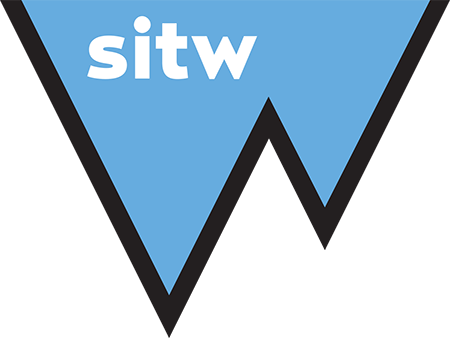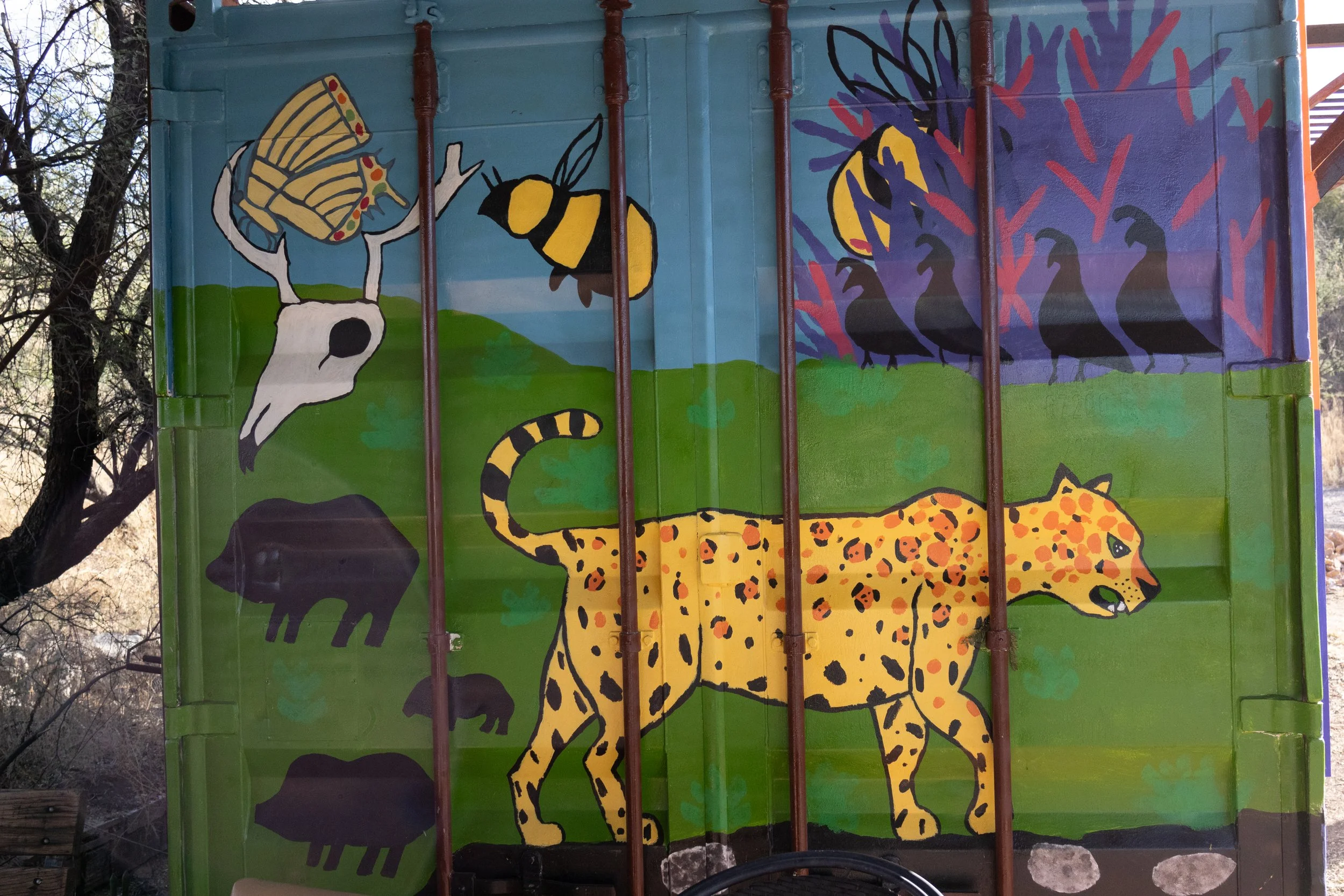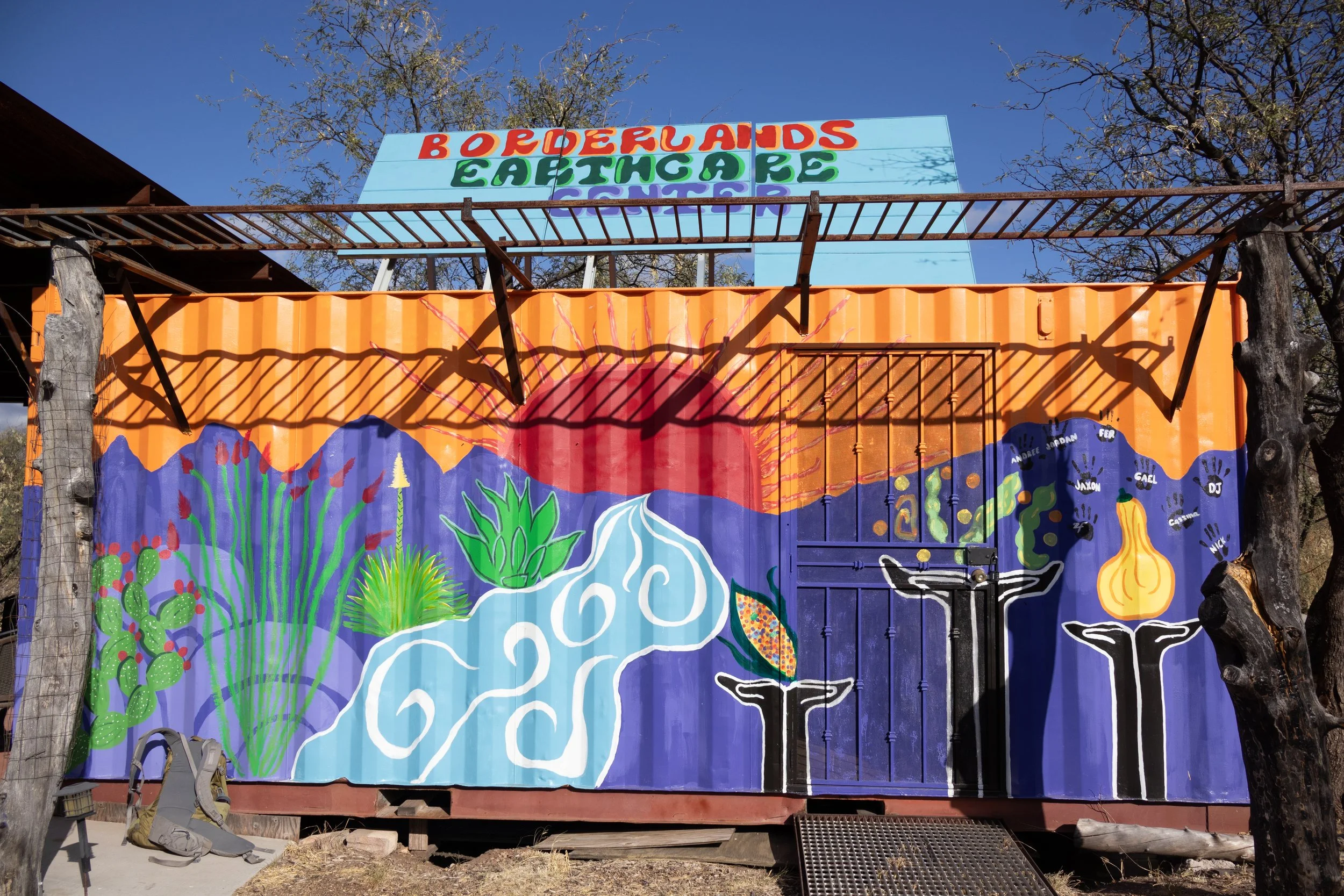Sunlight illuminates the ribbed surface of the storage container daubed with orange, blue, and green paint. The jaguar’s drooping eyes and bared teeth seem eternally fixed to his face. Trapped in the confines of the medium, he is imprisoned behind the container’s steel bars, a confinement parallel to that of the US-Mexico border twenty miles to his south. Monarchs and bees relish in their freedom above, soaring in winged companionship. The mural is both a celebration of biodiversity and an elegy to a world that thrived before the divisions of mining and border militarization.
The painted words, “Restore, Protect, and Reconnect,” grow like fruit upon the vines that blur the distinction between the storage container and the natural world. Borderlands Earth Care Youth meticulously painted this mural in the small town of Patagonia, Arizona. For Patagonia-area youth, this opportunity in conservation is highly unique in a region of sparse employment options.
Growing up twenty minutes from Patagonia, Jordan Sene spent her youth relishing in this incredible space, with the intention of returning to it to be a school teacher. Along with most rural students in the area, environmental science was absent in her education, and certainly as a potential career path. This all changed in 2018 when Jordan interned with Borderlands Earth Care Youth, a unique paid internship designed primarily for Hispanic, Latino, and low-income youth in the local Santa Cruz and Cochise counties. Now, she has returned as the Education Program Manager for Borderlands Restoration Network.
Jordan reaches into the lanky arms of mesquite trees with her loppers, trimming off brittle limbs with ease and familiarity, a brief reminder of where her work started. Six years ago, she was first introduced to environmental stewardship, “My first time at Deep Dirt Farm, now BECC, was the first time learning about environmental action, land protection, permaculture, and sustainability… and that is what drove me to my area of study and career path.” Now, she instructs similar restoration efforts to those she participated in herself, as well as leading education programs on the geography and biodiversity of the area.
Around Patagonia, the Sky Islands mountains emerge like adorned castles amongst an expanse of lowland desert, stretching drawbridges of the imagination between the Sierra Madre mountains of Mexico and the American Rocky Mountains. Within the palaces of these ranges is a dazzling array of biodiversity, nurtured by a unique combination of ecosystems that sustain over 7,000 precious species. Along with these animal and plant populations, this land has provided sustenance for Indigenous Sobaipuri, Papago, and Pima peoples for thousands of years.
In the last couple centuries, the history of this region has not been so bright. Riddled with colonialism and contestation, this land is no stranger to violence. Prior to and during the 1854 Gadsden Purchase of Southern Arizona from Mexico, Patagonia was a railroad town for lead and silver mining. Meanwhile, the border wall running through Nogales began construction, permanently dividing families as well as crucial migration corridors. The consequences of these decisions remain- in the form of divided communities, unemployed locals, and untreated toxic waste abandoned on the mountaintops.
Ten miles from Borderlands Earth Care Center, high in the Sky Islands of the Patagonia Mountains, a different storage container rests upon a patch of leveled ground, surrounded by fragments of broken rock. Its harsh gray exterior stands in stark contrast to the artfully reclaimed container at the preserve. Here, successive incisions have staggered the ground, exposing the pink flesh of raw earth. Roads meander like a labyrinth of veins passing through barren ground.
The recently developed Hermosa Mine is renewing the site of the Taylor Mine, a silver mine from the 1880s. Now, construction has begun for the company South 32, an operation for zinc, lead, silver, and most significantly, the only electric-battery-grade magnesium in North America.
From dawn to dusk, thirty to eighty trucks will groan up and down steep forest roads. Burdened with hazardous process chemicals, they make their pilgrimage towards the Hermosa mine site. If they make it safely into the mountains, these chemicals will be utilized to sever precious minerals from extracted rock. The toxic waste will be stacked and left behind, embodied permanently in the landscape.
The small, 800-person community that lives beneath this mountain fears a multitude of possible implications from the mine. Lingering over their heads, and under their feet, is the possible contamination of groundwater, a resource heavily relied upon for municipal water use. Further, the increased noise, construction, and traffic pose a threat of disturbance to crucial habitat for endangered wildlife.
Despite many locals' fears, the community faces a looming reality of economic dependency on these mining jobs. With the exception of Border Patrol, ranching, and limited medical and primary education jobs, few choices are available. Jordan recognizes the familiarly consequential pattern: “young people leave and they never come back.”
A simple Google search, “Jobs in Patagonia, Arizona,” presents an overwhelming number of mine related employment options. Rows of mining construction jobs populate, followed by more permanent jobs related to South 32, the mining company itself.
Borderlands Restoration Network envisions a world where economic success can be derived in conjunction with beneficial impacts to the environment. However, for many locals, the legacy and availability of mining jobs is impossible to ignore. Jordan sighs, “I have kids that still want to work for the mine, even graduating from my program… The influences around you really have a say in your direction of careers.” To pay the bills, sometimes moral compromises must be made.
Mining is a controversial industry woven into the fabric of the Southwest as deeply as cactus spines embedded into flesh. The road to change is daunting, and the town’s economy will not transform immediately. However, thanks to Borderlands, there are more opportunities for sustainable employment in Patagonia than ever before: working with native plants, doing stream restoration work, and for youth, paid restoration internships.
Here at the Earth Care Center, the land remarkably remembers how to nurture life. Nurseries teem with the vibrancy of leafy greens. Native seeds rest in dusty jars, fragile glass cradling the key to sustaining healthy ecosystems. Books teem from eclectic cupboards and weathered shelves. Outside, tired shovels and rakes hang heavily. Their rusty heads wobble underneath their own weight, loosened from lives of continuous toil.
Jordan’s eyes light with amazement as she reflects upon the space that embodies the love and dedication her students have poured into this community. “A big part of our curriculum is a sense of place.” Her students are deeply involved in place-based learning such as stream restoration work and native species identification. Jordan sees these opportunities as vital for the student’s growth—dually building skills of resilience and developing deep relationships with the land.
Tucking a strand of her light brown hair back into her ponytail, Jordan tilts her head up, proudly observing the expanse of shrubs and grasses that border the gentle curve of a rock-lined path. The carefully groomed trail is a product of the intentional care of community members and interns. “We're just wanting to showcase another option that there are nature-based solutions, and there are career pathways related to sustainability and taking care of the environment and stewardship.”
Borderlands Restoration Network is faced with a monumental task: to loosen the chokehold of violence and extractivism, and nurture a community that thrives instead on reciprocity. Everyday, their work invites more people to these spaces, to bask in the warm sunshine, the quiver of a cottonwood in the wind, and the chatter of birds. Jordan gazes once again upon the murals, “We run on passion.” Every stroke of color reflects the vibrancy of the lives that have touched it.



